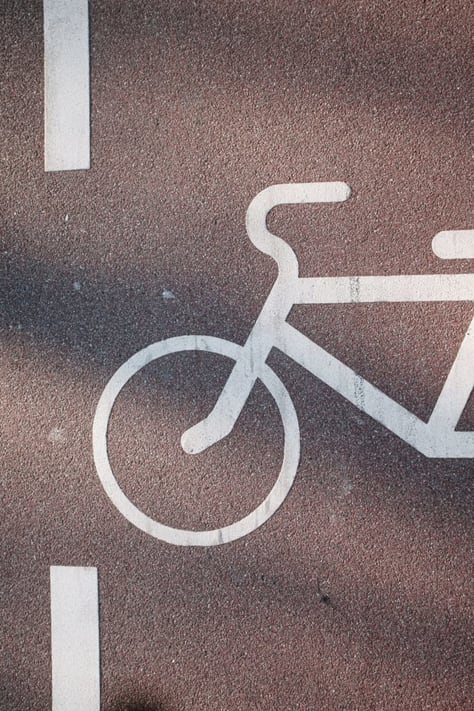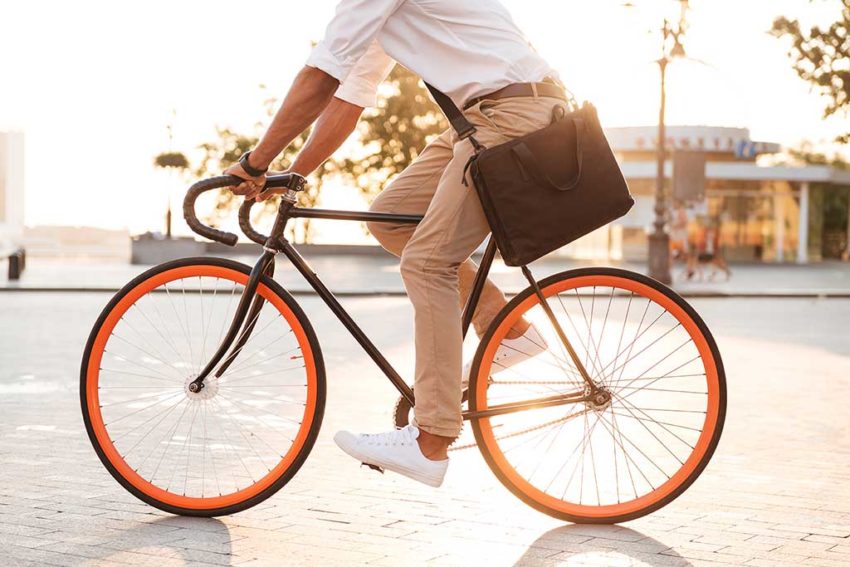Commuting by bike on urban streets is much different than a casual ride on a bike path. It is inherently more dangerous, things are moving a lot faster, there is more commotion, and it’s a lot louder. Being a confident and safe bike commuter requires preparation, some knowledge, a little practice and a few pieces of safety gear.
Before hitting the city roads on your bike, make sure to evaluate your comfort and only do as much as you’re comfortable with. Whether you’re new to bike commuting or not, here are some city-riding rules to keep in mind to help keep you safe:
“Hold Your Line” (aka Ride Straight, Stay in Your Lane, and Be Predictable)
Holding your line isn’t a term just for group rides and racing; this rule is one of the most important things you can do on a commute to help keep you safe out on the road too. Looking straight ahead and keeping your eyes where you want to go, instead of down at your wheel for example, helps you ride straight and predictably. Following this rule increases your ability to avoid and navigate potential obstacles in your path and avert any abrupt swerves, stops or illegal movements that can endanger you and others around you.
If you’re riding with or near other cyclists, maintain a safe distance to avoid overlapping your front wheel with the rear wheel of another bike. If the cyclist you’re “half-wheeling” makes a sudden move, it could cause both of you to go down.
Going hand in hand with riding as predictably as possible is communicating to cars, pedestrians and other cyclists around you. Always use hand signals when you need to turn, stop and slow suddenly.
Plan Your Route
Chances are you are already familiar with how to get from point A to point B by car. But keep in mind, what may feel easy or comfortable in a car may not be so fun on a bicycle so it’s important to plan your bike route before heading out. For safety and comfort, off-street bike paths and protected bike lanes should always be your first choice. If these are not an option, plan your bike route on well-used bike lanes on lesser-trafficked streets, or quiet back streets where speed limits are lower. If you are planning on commuting to work, it is a good idea to test your route on a day off so you can time it.
Honor The Rules of The Road
Colorado law defines bicycles as vehicles. This means that in addition to a specific set of bicycling laws, many of the same legal rights and duties that apply to motorists also apply to cyclists. If you’re on a street without a designated bike lane, for example, you are allowed to use the same lane as other motorists and you are allowed to take up as much space as a normal automobile would. In these cases, make sure to leave as much space between you and the car in front you to avoid other drivers from trying to squeeze in too closely. If you’re honked at, maintain composure and don’t feel pressured.
Sidewalks are intended for pedestrians, not vehicles. Because bicycles are considered vehicles in Colorado, bicyclists are prohibited (with a few exceptions) from using sidewalks. Biking on the sidewalk is allowed if the sidewalk is part of a designated bike route, if a bicyclist is delivering a paper, or when a bicyclist is within one block of preparing to mount/dismount. The speed limit for a cyclist riding on a sidewalk is 6 MPH.
Following the rules not only keeps you and others safe, but also makes you a good champion and advocate for the biking community as well.

Use the Turning Lane or Make a Box Turn
Although it may feel uncomfortable, if there is no bike infrastructure to maneuver otherwise, use the same lane as other motorists to turn left at an intersection. Remember to use your hand signals to make other drivers aware of your intentions.
If there are too many lanes to cross, the roads are busy, you’re nervous or if you’re unable to use the intersection for other reasons, use a box turn. A box turn is a maneuver when you proceed a small distance through an intersection on the right as you normally would, then stop at the far corner of the perpendicular street where you intended to turn left, wait for the traffic signal then ride with that flow of traffic.
Ride Defensively
Although cyclists have an equal right to use the public roadways, they are often bullied and subject to impatient drivers. Cyclists are far more likely to suffer severe or even fatal injuries because there are little to no structural elements that protect them from harm, making it even more important to ride defensively. Be aware of your surroundings and never assume drivers see you. Wear reflective gear, bright colors and use lights to increase your visibility. And always wear a helmet.
Look Out for Road Hazards & Obstacles
Cyclists are very susceptible to road hazards such as potholes, debris, loose rocks, and gravel. While riding, always keep an eye out for any obstacles in the road.
Do your best to avoid potholes as they can often lead to flat tires and crashes. Take corners carefully as well – city street corners tend to accumulate gravel which can cause you to slip out if you turn hard or at a high speed.
Road hazards become even more dangerous with poor weather conditions. Avoid puddles, as you don’t know what is underneath, as well as manhole covers, light rail tracks, roadwork plates. Because they are metal, they can become very slick in the rain or snow. Turning or riding on or over them can be very dangerous.
Finally, watch out for people. Pedestrians, often distracted by cell phones, step into bike lanes or crosswalks and jaywalk when there’s a gap in traffic. If the weather is bad, use extra precaution as pedestrians tend to take longer crossing the street and umbrellas can block a person’s line of sight. And depending on the time of day, be cognizant of the glare from the sun and use caution when riding near bars as alcohol impairment can compromise judgement.
Denver Bicycle Accident Attorneys
As avid riders ourselves, we have a close understanding of the rules and dynamics of bicycling, both on the road and on a trail. We also know that even the most experienced cyclists are not devoid of risks and dangers.
If you or a loved one were seriously injured in a bicycle accident or have questions about an incident you were involved with, please call us. We have extensive experience in bicycle cases and are here to help.
